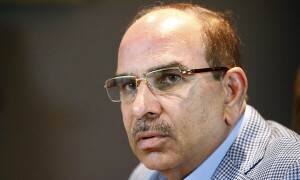A FUNDAMENTAL relationship between bonds and equities has broken down as the pressure for returns intensifies in an ever-expanding world of negative interest rates.
An insatiable thirst for income has driven both US bond yields and equity prices - two areas that traditionally move in opposite directions - into record territories.
In total-return terms the S&P 500 sits at an all-time high, vulnerable to persistent profit contraction at US companies, while long-dated Treasury yields have dropped to record lows, providing scant protection against higher inflation and a stronger economy.
The contradiction of bullish price performance in both US equities and bonds - corporate bond yields are also at multi-decade lows - strikes investors as the most compelling sign yet of how distorted markets have become eight years after central banks enacted zero-bound interest rate policies and became huge buyers of bonds.
“Policy is like a big elephant sitting on the rate structure and causing this distortion,” says Jim Paulsen, chief investment strategist at Wells Capital Markets.
As bond yields in Japan and Europe drive ever deeper below zero and Brexit casts a lengthy shadow over Europe and global growth prospects, investors say locking in income dominates portfolio objectives.
“That thirst for income is a direct function of the rate environment we are in,” says Russ Koesterich, director of asset allocation for the $45bn BlackRock Global Allocation fund.
“People can’t source yield from traditional sources.”
With an ever growing universe of negative-yielding bonds - at $12tn and counting - investors are flocking to higher-yielding US paper, while the equity rally reflects demand for safety in dividend-paying companies, utilities and telecoms.
The scale of this trade, however, has set a new mark, with investors shrugging aside the week before last’s robust June employment data from the US and pushing both bond and equity prices to new peaks.
Investors such as Michael Underhill, a portfolio manager at RidgeWorth Investments, talk about ‘Tina - There Is No Alternative’.
“You can stay in cash and have 1.5pc inflation erode your return, invest in bonds and get 1.2-1.5pc or negative yields abroad or invest in dividend-paying stocks and get 3, 4, sometimes 5pc,” he says. “That is what the average investor is challenged with in the current market environment.”
“As interest rates decline, the value of future cash flows increase. That’s just math,” says Nicholas Colas, chief market strategist at Convergex, who makes the point that, at around $100 per share of earnings for the S&P 500, ‘domestic stocks generate reasonable free cash flow and dividends’.
Yields, and therefore fixed returns over time, on longer-dated Treasuries have dropped to unprecedented levels.
However, for Japanese and European investors that have been grappling with negative yields for some time, the prospect of locking in a fixed rate below 1.40pc for a 10-year Treasury note or just 2.1pc for a 30-year bond remains attractive.
Demand is particularly strong among pension funds and insurance companies, according to traders and analysts, who buy longer-dated debt to balance against long-dated liabilities.
Between January and May this year, Japanese life insurance companies have collectively bought JPY6.2tn of foreign bonds, according to the Ministry of Finance. That is more than the JPY5.9tn they bought in the whole of 2015.
“Our traders are telling us that the impressive characteristic of the life insurers is that their buying is quite constant . . . For the last six to eight months the lifers just keep buying every day,” says Tomoaki Shishido, a senior rates analyst at Nomura.
The decision by UK voters to leave the EU has intensified this trend with the 10-year gilt yield falling well below 1pc, intensifying the status of US government debt as a ‘global high yielder’.
“Investor’s search for yield will continue,” says Putri Pascualy, a portfolio manager at Paamco. “For Treasuries, it is one of the few risk-free assets that is still yielding something.”
At such low yields, return is derived almost entirely from price movements, making it a profitable trade for those who invested earlier this year, but for those now entering the market, once Treasury yields rise and prices fall, losses could be sizeable.
“You are buying a fixed-rate coupon for a very long time so you better be happy to pay for that safety and pretty darn sure that central banks are not going to be successful in ultimately creating sustainable inflation,” says Dan Shackelford, a portfolio manager at T Rowe Price.
The bond market is only pricing in a one-fifth chance of an increase to interest rates by the Federal Reserve this year, despite jobs figures that were much stronger than forecast.
As foreign buyers continue to drive demand, some US investors are becoming wary.
“We tend to be more fundamental investors,” says Roger Bayston, a portfolio manager at Franklin Templeton. “We are not buying long-end Treasuries in our investment portfolio now.”
An alternative approach has been dividend-paying stocks, with utilities and telecoms both rising more than 20pc so far this year.
“The dichotomy there seems to be that a big slice of people’s portfolio is going for safety over yield and at the same time they are trying to search out where they can get some yield in stocks,” says JJ Kinahan, chief strategist at TD Ameritrade.
Additional reporting by Leo Lewis in Tokyo.
Published in Dawn, Business & Finance weekly, July 18th, 2016














































Dear visitor, the comments section is undergoing an overhaul and will return soon.